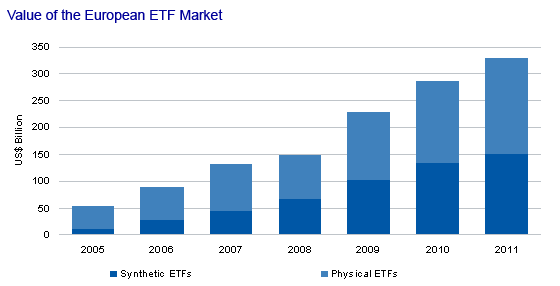Synthetic Exchange-Traded Funds in Europe
Getting Ready for Reform
Abstract
Europe is the leading global market for synthetic ETFs. Between 2006 and 2010, Europe had the highest levels of synthetic ETF issuance compared to the US and the rest of the world. Almost 90% of the issuance of synthetic ETFs in 2010 occurred in Europe.
In a new report, Synthetic Exchange-Traded Funds in Europe: Getting Ready for Reform, Celent discusses the evolution of the European ETF market, which has been quite different from its US and Asian counterparts. In the US, as a result of the various regulations, physical ETFs are preferred to synthetic ETFs. However, in the European market, the UCITS regulations have permitted greater freedom for the operation of synthetic ETFs.
The European ETF market has grown steadily between 2005-2011. The share of the synthetic ETF market has also grown over this period, rising from around 21% in 2005 to more than 45% of the value of the overall European ETF market in 2011.

“Synthetic ETFs seem to be cheaper than their physical counterparts, which partly explains their popularity,” says Anshuman Jaswal, Celent Senior Analyst and author of the report. “However, there are some concerns regarding their economic impact, and the European regulator ESMA is looking at the effect of synthetic ETFs on levels of counterparty and systemic risk.
This report provides an overview of the ETF market, with a focus on synthetic ETFs in Europe. A comparison of the regulatory framework in Europe with another leading market, the US, is also included in the overview. After this, the report looks at the development of synthetic ETFs in Europe and the change in market volumes in 2010–2011, which are occurring in response to volatility in the global markets, counterparty risk issues, and regulatory pressures. Finally, the report examines some of the major issues that exist as possible deterrents for investing in synthetic ETFs.

